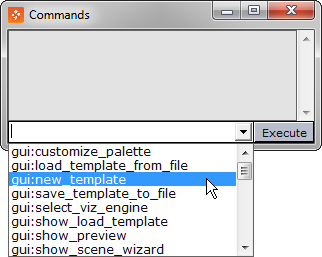
Viz Pilot User Guide
Version 8.1 | Published August 16, 2017 ©
Keyboard Configuration and Macros
This section contains the following topics:
-
Keyboard Configuration
-
Template Wizard Macro Commands
Keyboard Configuration
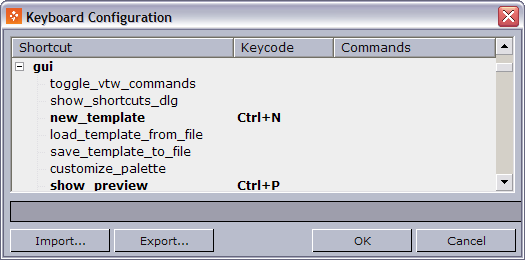
The Keyboard configuration window allows the user to select and define macros and assign them to specific key combinations, predefined functions and VB Scripts.
To open the Keyboard Configuration window select the Customize Keyboard option on the Tools menu.
This section contains the following topics:
-
Keyboard Configuration Window
-
To work with macros and shortcuts
-
-
Macro Shortcut
-
Predefined Functions for Keyboard Configuration
Keyboard Configuration Window
The columns in the window are:
-
Shortcut: Displays the macro name.
-
Keycode: Displays the keyboard shortcut.
-
Commands: Displays the shortcut command.
The buttons available are:
-
Import: Opens the Open window where a previously exported KBD (keyboard) file can be imported.
-
Export: Opens the Save As window where the current settings can be exported as a KBD file.
-
OK: Saves the keyboard shortcut configurations, and closes the window.
File location: %PROGRAMDATA%\Vizrt\Viz Pilot x.y\Config\vtw_keyboard.kbd -
Cancel: Closes the window.
The context menu contains the following options:
-
Add Macro: Opens the Macro Shortcut window, where a new macro can be created.
-
Delete Macro: Deletes the currently selected macro. Alternatively, click the keyboard shortcut CTRL+Delete.
-
Remove Shortcut: Deletes the shortcut key code of the currently selected macro. Alternatively, click the keyboard shortcut Delete.
To work with macros and shortcuts
-
To add a macro command, select Add Macro... .from the context menu to open the Macro Shortcut window, then enter the key combination, macro category:macro name and commands
-
To edit a macro command, double-click it to open the Macro Shortcut window.
-
To delete a macro command, select it and then either press the CTRL+DEL keys, or select Delete Macro from the context menu
-
To remove a macro command shortcut, select the macro and then either press the DEL key, or select Remove Shortcut from the context menu
Macro Shortcut
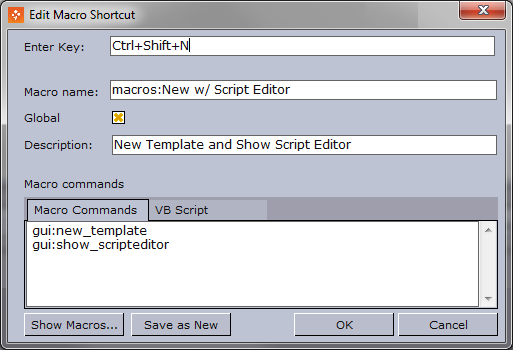
The New/Edit Macro Shortcut window is opened by selecting Add Macro from the Keyboard Configuration Window context menu, or double-clicking an existing macro.
The Macro Shortcut window contains the following fields and buttons:
-
Enter Key: Sets the keyboard shortcut for the macro. Place the cursor in this field and press the desired shortcut keys to set the key value.
-
Macro Name: Displays the macro category (e.g. macros:, gui:, viz: ) and the name of the macro. If a folder was selected when the Macro was opened, the category name will automatically be displayed in the Name text box. The category name can be set or changed in the Name field by adding the category and macro name separated by a colon (<macro category>:<macro name>).
Note: If a category is not added to the name it will be placed in the macros category. It is also possible to add new categories by defining them in the macro (e.g. foo:bar).
-
Global: Makes the macro work also when a template is open.
-
Description: Description of the macro.
-
Macro Commands: The names of the selected Predefined Functions for Keyboard Configuration are displayed.
-
VB Script: A text field where script code can be entered. This provides the possibility to further enhance and adapt the commands.
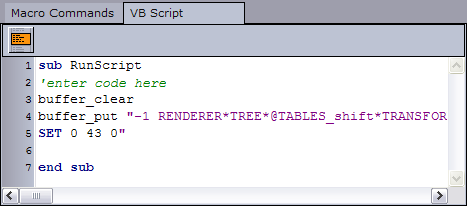
IMPORTANT! The function stub named RunScript must be used as the main script or entry point for other scripts; hence, it cannot be renamed or removed.
-
Show Macros: Opens the Predefined Functions for Keyboard Configuration window.
-
Save As New: Saves the macro as a new instance.
-
OK: Saves the macro, either as a new or modified macro.
-
Cancel: Closes the window, without saving any changes.
Predefined Functions for Keyboard Configuration
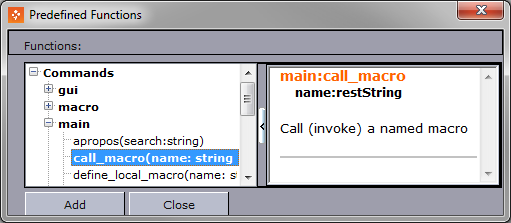
In the Predefined Functions window a list of the Commands that can be added to a keyboard shortcut is presented.
Note: Only the commands relevant for creating shortcuts are presented in this window. A more extensive list of predefined functions is available when using the Script Editor (see Script Editor Toolbar).
Template Wizard Macro Commands
Enables the user to execute predefined functions without using keyboard shortcuts and macros.
